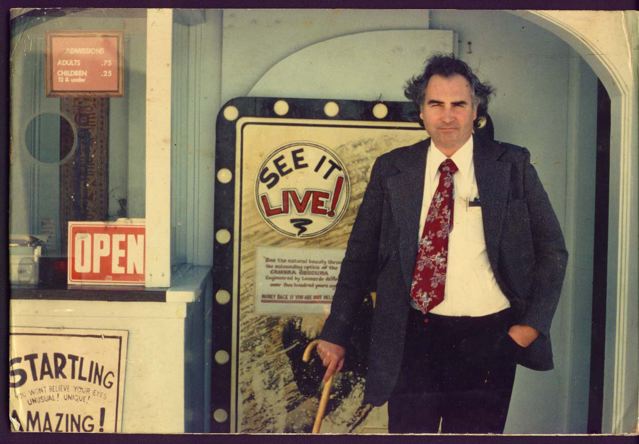
Warren at the entrance to the Giant Camera (circa 1983)

Warren at the entrance to the Giant Camera (circa 1983)
|
David Warren (aka. Flamo LaGrande, R.J. Mololepozy) was a founding member of the San Francisco Suicide Club. Son of a prominent building contractor in Hayward California, Dave spent his formative years in a carnival, doing fire eating and "guess your weight and age" joints. Later he became a crackerjack vacuum cleaner salesman and peddled Venus' Flytraps door-to-door (with a booklet he wrote suggesting cute Flytrap names, etc). By the late 1970s, his primary obsession was the demise of Playland at the Beach, a historic seaside amusement park in San Francisco that was razed in 1972 to make room for condo apartments. Dressed in a fireman's uniform with a helmet that read "Research Chief," Dave started his one-man Playland Research Center. Aside from a few scattered ruins of Playland and the Musée Mécanique (an operating collection of old and rare penny arcade devices), the only intact vestige of that once great area was a small yellow building behind the Cliff House overlooking Seal Rocks. It's facade resembled a camera lying on its back with film wind knobs on the front and a turret lens on its top. This was a camera obscura, one of four built by Floyd Jennings and Gene Turtle in the late 1940s, as tourist attractions in scenic locations. The camera obscura is essentially a pinhole camera with light entering a lens in the roof and sending a live image of the outside scene down onto a large concave dish in the center of the dark room. A rotating mirror up top presents a 360 degree view of the surroundings. Though it might seem paradoxical that someone would pay money to enter a dark room to view the same thing they could see outside for free, the rotating disembodied image of churning waves and coastline actually gains something mysterious and haunting when standing with strangers and gazing down into the detailed projection. Some part of this effect is the result of spacial dislocation and part is the dimmer more painterly effect the light has after passing the mirror and through the lens. This is particularly true at sunset where one can look directly at the sun as it settles behind a liquid horizon, it's last rays casting a shimmering path across the sea. When Dave Warren took over operation of the Giant Camera in 1978, it had been sitting closed up for years. Now a school administrator, Gene Turtle still owned the camera but had other demands on his time and the attraction was not a money maker. Dave however, was a man of ideas and under his stewardship the Giant Camera became famous again. Many articles were written both about the camera and Dave himself, giving him a platform to decry the destruction of Playland and helping in his valiant efforts to save a portion of the property from development (that corner parcel of land is still free of buildings to this day). Since I was a good friend of Dave through Suicide Club activities, it was a privilege to have a turn at running the Giant Camera along with another friend Chris DeMonterey. We all came up with various tactics to get people to experience this unique attraction. I observed that an old Life magazine article (from the early 1950s) that was mounted near the entrance attracted attention but after reading the explanation many would not enter, feeling that the printed word sufficed for the experience. I decided to cover that article with a large question mark and even placed question marks with arrows pointing the way to the Camera. When a visitor approached the glass ticket booth, I held up a small sign with a question mark. When asked what the place was, I silently flipped the sign around. On the back it read "It's only fifty cents." Though we had no real surveys, I did feel that the question marks increased attendance. Special events were initiated. Bands would sometimes play on the roof. Performance artists planned their pieces around being watched from inside. We even had a contest where composers had an opportunity to write special music for the interior of the camera. My favorite entry was a quartet for musical saws where the players sat inside around the walls, playing their saws in the dark while people filed through. Later, Chris thought of mounting holograms around the walls to contrast the early camera obscura with later achievements in photography. All this attention drew the scorn of the Cliff House owner who pressed the GGNRA (Golden Gate Park Service) to have the Giant Camera demolished. They claimed it was a tacky eyesore that marred the pristine view of restaurant patrons. Dave and Chris started a petition drive to save the camera and it succeeded in halting the proposed destruction. In 2001, the Giant Camera Obscura was finally given historic building status, guaranteeing its future existence. Unfortunately Dave lost control of both his sobriety and potential ownership of the camera. Since his departure as operator, the Giant Camera just isn't what it used to be. Several other misfortunes followed: The remodeling of the Cliff House limited access to the back patio where the Camera resides. The Musée Mécanique moved to Fisherman's Warf, and most surprisingly, the population of sea lions that for generations rested and played on Seal Rocks, have been lured to the docks of Pier 39, far from the Cliff House. Without someone with Dave Warren's inventive knack for publicity, the Giant Camera Obscura may again become a closed box. — Steve Mobia
more about the Giant Camera Obscura article on Dave Warren Where is Dave Warren today? Great old photos of the Cliff House Photos from Playland at the Beach and Richard Tuck's Playland Not at the Beach
|
|---|